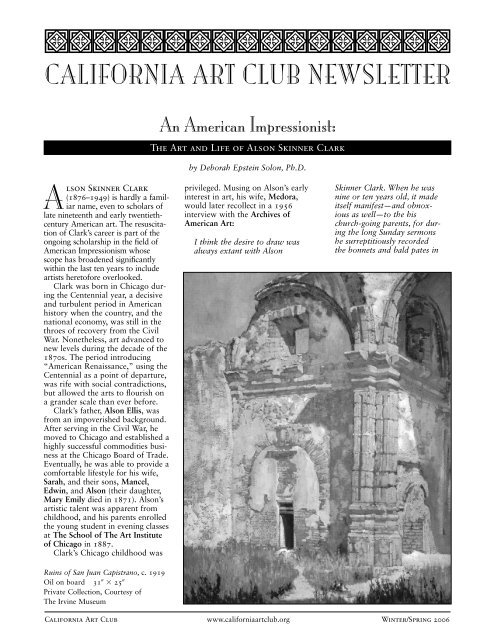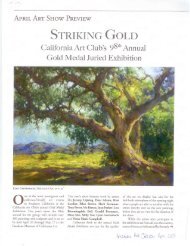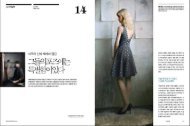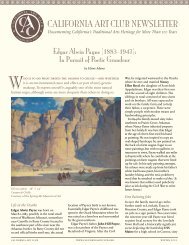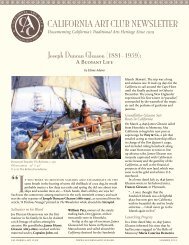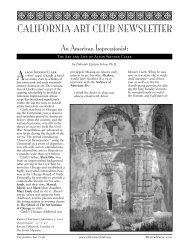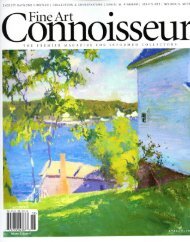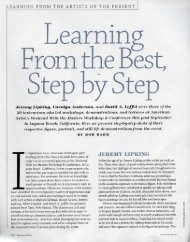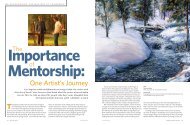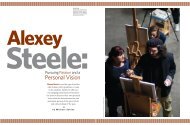(1876-1949) – An American Impressionist, by Deborah Epstein Solon
(1876-1949) – An American Impressionist, by Deborah Epstein Solon
(1876-1949) – An American Impressionist, by Deborah Epstein Solon
You also want an ePaper? Increase the reach of your titles
YUMPU automatically turns print PDFs into web optimized ePapers that Google loves.
CALIFORNIA ART CLUB NEWSLETTER<br />
Alson Skinner Clark<br />
(<strong>1876</strong><strong>–</strong><strong>1949</strong>) is hardly a familiar<br />
name, even to scholars of<br />
late nineteenth and early twentiethcentury<br />
<strong>American</strong> art. The resuscitation<br />
of Clark’s career is part of the<br />
ongoing scholarship in the field of<br />
<strong>American</strong> Impressionism whose<br />
scope has broadened significantly<br />
within the last ten years to include<br />
artists heretofore overlooked.<br />
Clark was born in Chicago during<br />
the Centennial year, a decisive<br />
and turbulent period in <strong>American</strong><br />
history when the country, and the<br />
national economy, was still in the<br />
throes of recovery from the Civil<br />
War. Nonetheless, art advanced to<br />
new levels during the decade of the<br />
1870s. The period introducing<br />
“<strong>American</strong> Renaissance,” using the<br />
Centennial as a point of departure,<br />
was rife with social contradictions,<br />
but allowed the arts to flourish on<br />
a grander scale than ever before.<br />
Clark’s father, Alson Ellis, was<br />
from an impoverished background.<br />
After serving in the Civil War, he<br />
moved to Chicago and established a<br />
highly successful commodities business<br />
at the Chicago Board of Trade.<br />
Eventually, he was able to provide a<br />
comfortable lifestyle for his wife,<br />
Sarah, and their sons, Mancel,<br />
Edwin, and Alson (their daughter,<br />
Mary Emily died in 1871). Alson’s<br />
artistic talent was apparent from<br />
childhood, and his parents enrolled<br />
the young student in evening classes<br />
at The School of The Art Institute<br />
of Chicago in 1887.<br />
Clark’s Chicago childhood was<br />
Ruins of San Juan Capistrano, c. 1919<br />
Oil on board 31 25<br />
Private Collection, Courtesy of<br />
The Irvine Museum<br />
<strong>An</strong> <strong>American</strong> <strong>Impressionist</strong>:<br />
The Art and Life of Alson Skinner Clark<br />
<strong>by</strong> <strong>Deborah</strong> <strong>Epstein</strong> <strong>Solon</strong>, Ph.D.<br />
privileged. Musing on Alson’s early<br />
interest in art, his wife, Medora,<br />
would later recollect in a 1956<br />
interview with the Archives of<br />
<strong>American</strong> Art:<br />
I think the desire to draw was<br />
always extant with Alson<br />
Skinner Clark. When he was<br />
nine or ten years old, it made<br />
itself manifest—and obnoxious<br />
as well—to the his<br />
church-going parents, for during<br />
the long Sunday sermons<br />
he surreptitiously recorded<br />
the bonnets and bald pates in<br />
California Art Club www.californiaartclub.org Winter/Spring 2006
2<br />
front of him in the only place<br />
available at the time—the<br />
frontispiece and blank rear<br />
pages of the family hymnals.<br />
In 1889 the Clark family<br />
embarked on a two-year trip<br />
around the world. This experience<br />
gave young Alson his first introduction<br />
to European art and perhaps<br />
was the catalyst to his future insatiable<br />
appetite for travel and painting.<br />
We know much about Clark<br />
through his diaries and letters—the<br />
quotidian diary entries for the<br />
young Alson in Europe focused on<br />
food, the weather and his studies,<br />
but also discussed the churches,<br />
museums, galleries, and opera performances<br />
the family attended.<br />
Upon graduating from high<br />
school, Clark briefly enrolled as a<br />
full-time student at The School of<br />
the Art Institute of Chicago where<br />
the traditional academic program<br />
(mostly dependent upon French<br />
principles) included requisite drawing<br />
from casts and still-lifes before<br />
Taking Paintings to the Salon, Paris, c. 1905<br />
Collection of Jean Stern, The Estate of Alson Clark<br />
advancing to the live model. In<br />
1896, following a disagreement<br />
with one of his teachers, and displeased<br />
with what he considered<br />
the slow and laborious process of<br />
drawing from casts, Clark quit the<br />
school. Determined to continue his<br />
studies, Clark moved to New York<br />
to work under the tutelage of<br />
William Merritt Chase<br />
(1849<strong>–</strong>1916) at the Art Students’<br />
League of New York.<br />
Although Clark’s parents supported<br />
his intention to become a<br />
painter, his mother was concerned<br />
about her twenty-year-old son living<br />
alone in New York; so she went<br />
with him. Adding to the unusual<br />
arrangement, Alson’s childhood<br />
friend Amelia Baker joined them.<br />
The three shared a flat at Seventy-<br />
Seventh Street and Columbus<br />
Avenue. According to Sarah Clark:<br />
“For two years Mela [Amelia] and<br />
I have talked of spending a winter<br />
in New York, in Bohemian fashion,<br />
and have searched for a good reason<br />
for doing so, in vain till this<br />
time. Alson, however, came to the<br />
rescue in his desire to study art<br />
with a New York master, and made<br />
it seem a necessary thing to do.”<br />
When Chase opened his<br />
own school, Clark, among<br />
many other students, followed him.<br />
A dedicated and sympathetic<br />
instructor, Chase’s influence on<br />
Clark was enduring throughout the<br />
young artist’s career. In fact, Clark’s<br />
Early Nude (1898) bears an<br />
inscription that Chase actually<br />
worked on the painting. The two<br />
summers Clark spent working en<br />
plein air at Chase’s school in Shinnecock,<br />
Long Island presaged his<br />
inclination towards <strong>Impressionist</strong><br />
practices.<br />
Clark left to study in Paris in<br />
November 1898, but had reservations<br />
about leaving his family. He<br />
wrote in his diaries: “My dear<br />
Mama, how I hate to leave her for<br />
so long. I do love her so.” Aspiring<br />
young <strong>American</strong> painters had several<br />
options for instruction in Paris,<br />
but <strong>by</strong> far the most popular school<br />
was the Académie Julian. Nonetheless,<br />
Clark rejected the Julian, finding<br />
the working conditions there<br />
“disgusting.” Instead, he enrolled<br />
in the newly opened, Academia<br />
Carmen, James Abbott McNeill<br />
Whistler’s (1834<strong>–</strong>1903) short-lived<br />
school. This decision was surprising,<br />
as Whistler was the artistic<br />
antithesis of Chase. Known for his<br />
phlegmatic temperament, Whistler<br />
was ill-suited to the demands of an<br />
instructor. At first, Clark found the<br />
school “rotten.” The tuition was<br />
higher than at other schools, strict<br />
rules of decorum were enforced,<br />
and Whistler’s critiques were often<br />
more theatrical than instructional.<br />
On one rare occasion Whistler<br />
held a small soirée for his students<br />
at the studio. There, Clark acquired<br />
insight into Whistler’s working<br />
methods:<br />
He showed us several of his<br />
starts and finished pictures.<br />
They were elegant and really<br />
almost came up to the Old<br />
California Art Club www.californiaartclub.org Winter/Spring 2006
3<br />
Masters. His things are so<br />
simple that you look at them<br />
a moment and everything<br />
comes out but nothing pushes<br />
itself forward so that you<br />
notice it especially but see the<br />
whole thing.…He arranges his<br />
palette very queerly. He first<br />
has black, then raw umber,<br />
light red, burnt sienna, Prussian<br />
blue, burnt umber, some<br />
more black, vermilion, raw<br />
sienna, yellow ochre and<br />
white.…His studio is very<br />
dimly lighted and all the walls<br />
are of a warm, dark pink.<br />
Clark recognized the quixotic<br />
artist’s genius. He was a willing<br />
acolyte, and attended Whistler’s<br />
atelier intermittently until the<br />
school’s demise in 1901. By this<br />
time Whistler had a profound effect<br />
on Clark, even the way he arranged<br />
his own palette.<br />
In March of 1899, Clark entered<br />
his first work in the Paris Salon. In<br />
a letter written the following month<br />
to Amelia Baker, he described his<br />
experience:<br />
Wednesday Wilson and I went<br />
to the Salon to see the stuff<br />
carried in and all the awful<br />
things that went in—I never<br />
saw such a lot of bad painting.<br />
The wagons come up to<br />
the entrance and take their<br />
wads of pictures in and there<br />
are crowds of people watching<br />
the stuff enter. I have little<br />
hope that [my picture] will<br />
pass the jury but one can<br />
never tell as there is a great<br />
deal of “pull” in the Salon,<br />
and as I have not studied<br />
under any Frenchman I may<br />
be thrown out. I don’t care<br />
what happens although of<br />
course I would rather be in<br />
than out. Exhibitions are,<br />
after all, a farce.<br />
When his painting was rejected,<br />
Clark pretended indifference: “It<br />
doesn’t’ matter to me at all as I<br />
haven’t a reputation to make and<br />
there isn’t much honour in being in<br />
unless you get in squarely as only<br />
very few do.…” Nonetheless, inclusion<br />
continued to be his goal and<br />
when his work, The Violinist<br />
(1901), was accepted later in 1901,<br />
he was hardly nonchalant.<br />
Whistler’s early influence is seen in<br />
Clark’s first successful entry in the<br />
Paris Salon. The Violinist allows for<br />
the exploration of muted hues of<br />
brown and green to explain a sombre,<br />
brooding mood. The primary<br />
sense is of a compositional arrangement—the<br />
placement of the solitary<br />
individual and the exploration of<br />
dark colour—as opposed to interest<br />
in personality or narrative.<br />
Clark was repeatedly ill<br />
and while living in New York<br />
he went frequently to the doctor to<br />
have his stomach “pumped.” In the<br />
spring of 1901, he suffered increasing<br />
physical infirmities. Told that<br />
he needed an appendectomy—a<br />
serious operation at the time—he<br />
booked passage back to America<br />
on June 1 and scheduled the surgery<br />
in Chicago.<br />
Clark spent the summer of 1901<br />
at the family summer home on<br />
Comfort Island, one of the Thousand<br />
Islands in Alexandria Bay. In<br />
the fall, he rented a barn in Watertown<br />
from Amelia’s parents and<br />
converted it into a studio. Watertown<br />
was a small, provincial city<br />
near Lake Ontario and the Canadian<br />
border and the closest city to<br />
Comfort Island. His decision to<br />
stay in Watertown marked the<br />
beginning of his professional career<br />
and heralded a new chapter in his<br />
personal life. He had gained experience<br />
and sophistication through his<br />
sojourn in Paris. Now, still strongly<br />
influenced <strong>by</strong> both Chase and<br />
Whistler, he began to develop a<br />
personal vocabulary.<br />
Clark was the only professional<br />
artist living in Watertown, and one<br />
of the local girls, Atta Medora<br />
McMullin, agreed to pose as a<br />
model—with her mother as a chaperone.<br />
Unexpectedly, love blossomed,<br />
despite the artist’s appre-<br />
CALIFORNIA ART CLUB<br />
NEWSLETTER<br />
Winter/Spring 2006<br />
Contents<br />
Cover <strong>An</strong> <strong>American</strong><br />
<strong>Impressionist</strong>: The Art<br />
and Life of Alson<br />
Skinner Clark<br />
<strong>by</strong> <strong>Deborah</strong> <strong>Epstein</strong><br />
<strong>Solon</strong>, Ph.D.<br />
10 Calvin Liang: His<br />
Own Voice<br />
<strong>by</strong> Elaine Adams<br />
14 Letter from Iraq<br />
15 CAC News Flash:<br />
Stars Shine Bright at<br />
Marston’s Restaurant<br />
16 CAC News Briefs<br />
16 2006 CAAM<br />
Workshops<br />
17 Donor Recognition<br />
18 Museum/Gallery<br />
Exhibitions and<br />
Lectures<br />
26 Membership News<br />
28 Bulletin Board<br />
29 New Members<br />
30 In Memoriam<br />
Advertisers<br />
26 <strong>American</strong> Legacy Fine<br />
Arts, LLC<br />
27 Source Tek<br />
28 Lifescapes<br />
California Art Club www.californiaartclub.org Winter/Spring 2006
4<br />
The Violinist, c. 1901<br />
Oil on canvas 26 22<br />
Collection of Huntington Library, Art Collections and Botanical Gardens,<br />
San Marino, California<br />
Gift of Alson Clark, Jr.<br />
hensions. “In the evening I would<br />
have liked to have seen Medora,<br />
but stayed home and wrote. I have<br />
no more business in marrying than<br />
the man in the moon for I am fickle<br />
and can’t help myself. It is a misfortune<br />
and not a fault.” Yet, just a<br />
few days later, he wrote, “In the<br />
afternoon she posed. I could not<br />
work as I wanted to tell her that I<br />
loved her but could not. We sat <strong>by</strong><br />
the fire knowing each other’s<br />
minds.” By the end of January,<br />
Clark professed his love.<br />
From the beginning, Medora<br />
proved to be a supportive partner,<br />
assisting Clark as he organized his<br />
first solo exhibition in Watertown.<br />
Always cognizant of his obligations,<br />
on the eve of the exhibition,<br />
Clark wrote: “Tomorrow begins<br />
my career as an artist and with that<br />
the knowledge that some of my<br />
works may bring us our living.” In<br />
fact, financially he was more fortunate<br />
than most artists. In the<br />
1890s, his father had purchased the<br />
Wadsworth-Howland Paint Company<br />
(later renamed the Jewel Paint<br />
Company), in the hope that his<br />
sons would enter the business. The<br />
business provided income for the<br />
artist and his siblings throughout<br />
their lives.<br />
Clark was thrilled about his first<br />
exhibition, which featured small<br />
paintings depicting the city of Paris:<br />
Approximately forty people<br />
attended, and a few pictures sold:<br />
Medora considered the event a<br />
“grand success.” From Watertown,<br />
the paintings travelled to Chicago<br />
for Clark’s first major exhibition, at<br />
the <strong>An</strong>derson Galleries. Critical<br />
response was overwhelmingly positive<br />
for the “Chicago boy,” with a<br />
consensus that the “young man certainly<br />
has decided talent.” The<br />
Chicago Tribune declared, “Popular<br />
opinion has decided that it is a<br />
very promising display for a young<br />
artist…. Mr. Clark has a style of<br />
his own. It is suggestive of Japanese<br />
reminiscences, is refined and pleasantly<br />
frank…. The sentimental does<br />
not interfere with the boldness of<br />
using masses.”<br />
Alson and Medora, as she was<br />
known, were wed on September<br />
20, 1902, and sailed on the S.S.<br />
Minnetonka for a Europe. On<br />
November 7, they moved into an<br />
apartment at 6, rue Victor-Considérant<br />
in Paris. Soon after settling<br />
in, Alson’s friend, artist Frederick<br />
Carl Frieseke (1874<strong>–</strong>1939), moved<br />
in with them until the rooms above<br />
their apartment became available.<br />
Among the constellation of <strong>American</strong><br />
artists in France during the<br />
early twentieth century, Clark’s<br />
friends included such notables as<br />
Lawton S. Parker (1868<strong>–</strong>1954),<br />
Will Howe Foote (1874<strong>–</strong>1965),<br />
Henry S. Hubbell (1870<strong>–</strong><strong>1949</strong>),<br />
Richard E. Miller (1875<strong>–</strong>1943),<br />
and Guy Rose (1867<strong>–</strong>1925). However,<br />
he was especially close to<br />
Frieseke in the early years. Frieseke<br />
painted from the Clarks’ apartment<br />
balcony and occasionally used<br />
Medora as a model. The artists<br />
worked assiduously during the winter<br />
in order to prepare for the<br />
spring Salon. As part of the preparation,<br />
many analyzed each other’s<br />
works. Some assisted each other<br />
when it came time to deliver paintings<br />
to the Salon, often renting and<br />
sharing wagons. They even<br />
California Art Club www.californiaartclub.org Winter/Spring 2006
5<br />
exchanged formal clothing to wear<br />
at openings: “Many painters didn’t<br />
possess the required outfit, so there<br />
would be a hurried return to some<br />
base, a quick exchange, and the<br />
frock coat and hat would make a<br />
second trip to the Salon on a<br />
smaller, but happy man.”<br />
Clark meticulously documented<br />
his paintings on small note cards or<br />
in notebooks, often with tiny photographs.<br />
He wrote “Whistler” on<br />
several of these cards, unabashedly<br />
confirming his indebtedness to the<br />
master. The Necklaces (Les Colliers)<br />
(1905) is perhaps his greatest homage<br />
to Whistler’s portraiture.<br />
Clothed in a flowing gown and<br />
placed in front of an elegant mantelpiece,<br />
Medora stands with her back<br />
to the viewer as she examines different<br />
necklaces. The title refers not to<br />
the model but rather to the objects<br />
she holds, removing any association<br />
with her individuality. Even as Clark<br />
matured—and aligned himself with<br />
<strong>Impressionist</strong> practices—Whistler’s<br />
influence still endured.<br />
The Clarks travelled extensively<br />
while maintaining their Parisian<br />
residence, visiting Normandy,<br />
Giverny, parts of Italy and Spain,<br />
the Netherlands, Dalmatia, and<br />
Canada, periodically returning to<br />
Comfort Island, Chicago and New<br />
York to sell his “<strong>American</strong>” paintings<br />
through the art dealer William<br />
Macbeth, who favoured <strong>American</strong><br />
subject matter.<br />
After painting in Spain,<br />
Clark was eager to organize his<br />
Spanish paintings for an exhibition<br />
in America, and so the Clarks<br />
returned to Chicago in January<br />
1910. A show of the Spanish paintings<br />
opened at the O’Brien Art Galleries<br />
in March of that year. Seventeen<br />
of the thirty-eight canvases<br />
sold immediately. His New York<br />
dealer, Macbeth, agreed to exhibit<br />
works that were still available.<br />
The Clarks returned to Paris,<br />
but <strong>by</strong> June they left for a visit to<br />
the artist colony in Giverny, returning<br />
again for a short stay in October.<br />
Giverny’s fame is associated<br />
with its most distinguished resi-<br />
dent, Claude Monet (1840<strong>–</strong>1926).<br />
However, an <strong>American</strong> colony was<br />
first established there in the 1880s,<br />
and <strong>by</strong> 1910 <strong>American</strong>s were well<br />
entrenched. The influx of tourists<br />
and artists to this village caused a<br />
surge in prices from everything<br />
from food to real estate. <strong>An</strong>d, figuratively<br />
speaking, the <strong>American</strong><br />
community was highly incestuous.<br />
They lived, painted, played, and<br />
argued all within full sight of each<br />
other. Ultimately, Medora did not<br />
find it a convivial atmosphere:<br />
The Necklaces (Les Colliers), 1905<br />
Oil on canvas 38 3/4 30 1/8<br />
Collection of Earl and Elma Payton<br />
“The more I reflect on the possibilities<br />
of Giverny as a place to go, the<br />
less I care for it. The petty jealousies…the<br />
fights, the spying on<br />
you <strong>by</strong> your neighbours all works<br />
up to the least attractive place…to<br />
spend a season. Then the similarity<br />
in all of the work. I have kept out<br />
of it.” However, in Giverny, Clark<br />
solidified his commitment to<br />
Impressionism. Like most <strong>American</strong>s,<br />
Clark practiced a modified<br />
form of Impressionism, one that<br />
allowed him to combine his aca-<br />
California Art Club www.californiaartclub.org Winter/Spring 2006
6<br />
demic drawing skills with the chromatic<br />
and stylistic freedom of<br />
<strong>Impressionist</strong> practices.<br />
Clark’s paintings were included<br />
at venues such as The Art Institute<br />
of Chicago, The Pennsylvania<br />
Academy of the Fine Arts, the Paris<br />
Salon, and the National Academy<br />
of Design. His continual thirst for<br />
new subjects proved financially successful:<br />
a steady stream of sales<br />
through his dealers in Chicago and<br />
New York provided a modest, but<br />
satisfactory income.<br />
In the spring of 1913, the<br />
Clarks decided rather spontaneously<br />
to visit the Panama Canal<br />
Zone. Construction on the vast<br />
and costly canal was nearing completion,<br />
and Clark was determined<br />
to somehow be involved in the<br />
epoch-making enterprise. Although<br />
they arrived in Panama without<br />
letters of introduction or accommodations,<br />
both were eventually<br />
secured. The supreme commander<br />
of the project gave Clark unprecedented<br />
access to the labour trains<br />
and construction sites, where the<br />
artist worked furiously in the stifling<br />
heat to portray the excavations,<br />
the construction of the locks,<br />
and the ubiquitous railroad.<br />
Clark wrote to his mother:<br />
This is such a busy place for<br />
me I never get time to write<br />
more than a postal. We get<br />
off on the 6:40 train in the<br />
morning, getting up at fivethirty<br />
or so and get back at<br />
noon, leave for lunch and go<br />
off again at one-thirty, getting<br />
in at seven and after dinner<br />
go to bed…. In the afternoon<br />
at present I go to the Culebra<br />
Cut where all the blasting has<br />
been going on and the slides,<br />
and I paint there. It is wonderful<br />
all over….<br />
By June, with a significant number<br />
of canvases completed, Clark<br />
In the Lock, 1913<br />
Oil on canvas 25 31<br />
Collection of W. Donald Head/Old Grandview Ranch<br />
Alson Skinner Clark (<strong>1876</strong><strong>–</strong><strong>1949</strong>)<br />
Catfish Row (also known as Cabbage Row), c. 1917<br />
Oil on canvas 26 32<br />
Collection of Paul and Kathleen Bagley<br />
California Art Club www.californiaartclub.org Winter/Spring 2006
7<br />
contacted John Trask, the director<br />
of fine arts for the forthcoming<br />
1915 Panama-Pacific International<br />
Exposition. Although Clark’s impetus<br />
for painting the canal was<br />
purely personal, he quickly he recognized<br />
the value of these celebratory<br />
images for the exhibition.<br />
Trask agreed, granting the artist a<br />
room to exhibit eighteen paintings.<br />
With such a distinction, Clark<br />
joined the ranks of luminaries similarly<br />
honoured with their own<br />
rooms in San Francisco, among<br />
them Frank Duveneck (1848<strong>–</strong>1919),<br />
William Merritt Chase, Childe Hassam<br />
(1859<strong>–</strong>1935), Edmund Tarbel<br />
(1862<strong>–</strong>1938), John Twachtman<br />
(1853<strong>–</strong>1902), James Abbott<br />
McNeill Whistler, and John Singer<br />
Sargent (1856<strong>–</strong>1925).<br />
The Clarks were vacationing in<br />
France during the summer of 1914<br />
when World War I erupted. Based<br />
on correspondence in August 1914<br />
from Clark to his mother, they were<br />
completely stunned and underestimated<br />
the situation’s gravity. “Perhaps<br />
<strong>by</strong> the time you get this,” he<br />
wrote, “all will have blown over<br />
and there will not be anything to<br />
worry about.” Temporarily<br />
stranded—and facing the conundrum<br />
of getting themselves and the<br />
Panama paintings back to America—they<br />
eventually secured passage<br />
on a ship, rolled the massive canvases,<br />
and carried them as luggage.<br />
Forced to remain in<br />
America, the Clarks accepted an<br />
invitation from Charles and Edith<br />
Bittinger, friends from the early<br />
days in Paris, to visit them in New<br />
England during the winter of 1916.<br />
Clark was invigorated <strong>by</strong> the chilly<br />
New England climate, painting en<br />
plein air in snowshoes. In January<br />
1917, they agreed to join another<br />
couple on a “short trip” to<br />
Charleston. Clark had spent very<br />
little time in the South, and was<br />
overcome <strong>by</strong> Charleston’s charm<br />
and history. He enjoyed the genteel<br />
Southern hospitality and undoubtedly<br />
would have stayed if not for a<br />
stunning turn of events. When the<br />
United States entered World War I<br />
on April 16, 1917, they immediately<br />
left Charleston and returned<br />
to Chicago; at age forty-one, Clark<br />
enlisted in the Navy.<br />
Although hardly a candidate for<br />
conscription, Clark believed that his<br />
fluency in French and familiarity<br />
with the French countryside could<br />
be useful. Originally assigned as a<br />
translator, he was subsequently<br />
reclassified as a military photographer<br />
in May 1918. He was assigned<br />
to take aerial surveillance photographs<br />
while dangling precariously<br />
over the side of an open plane, an<br />
F2A Flying Boat. The experience<br />
left him deaf in one ear—a condition<br />
deemed reversible—and Clark<br />
was advised to live in a warm climate<br />
when he returned to America.<br />
Opting to go west—but knowing<br />
nothing about California—the<br />
Clarks reluctantly left for Los<br />
<strong>An</strong>geles, arriving in February 1919.<br />
As they travelled across the country,<br />
Clark announced to Medora<br />
that he would no longer paint.<br />
Although Clark’s diaries do not<br />
refer to this rather radical pronouncement,<br />
fresh from the horrors<br />
of war, he may have viewed his<br />
painting career as insipid. However,<br />
once in California, his hearing<br />
steadily improved; he regained his<br />
spirits and resumed painting.<br />
Southern California offered Clark<br />
new and exciting possibilities for his<br />
art through the diversity of landscapes,<br />
romantic Spanish Colonial<br />
missions, and the proximity to<br />
exotic Mexico. The Mission San<br />
Gabriel and Mission San Juan<br />
Capistrano became familiar haunts<br />
for the Clarks, with Alson delighting<br />
in the decaying architecture<br />
weathered <strong>by</strong> time and the unusual<br />
Western flora. Ruins of San Juan<br />
Capistrano (c. 1919) underscores<br />
the dignity of this artefact, even in<br />
its ruinous state. In 1919, intending<br />
to remain in California until they<br />
could return to Paris, the couple<br />
purchased a parcel of land with a<br />
“shack” in Pasadena. As California<br />
became more familiar, a new home<br />
and studio were constructed. Clark<br />
refurbished a Dodge truck, which he<br />
equipped for plein air painting, and<br />
travelled to Banning, Hemet, the<br />
High Sierra and Palm Springs with<br />
artists Orrin White (1883<strong>–</strong>1969)<br />
and John Frost (1890<strong>–</strong>1937).<br />
Two significant events<br />
marked Clark’s early years in California:<br />
a reunion with a friend from<br />
France, Guy Rose, and the birth of<br />
his son. Rose returned to his native<br />
California to teach at the newly<br />
formed Stickney School of the Fine<br />
Arts in Pasadena. He became director<br />
in 1918 and asked Clark to join<br />
the faculty. When Rose suffered a<br />
debilitating stroke in 1921, Clark<br />
assumed the directorship. That same<br />
year, Clark’s son, Alson Jr., was<br />
born. The euphoria of his new ba<strong>by</strong><br />
was tempered <strong>by</strong> the rigors of caring<br />
for a newborn. Accustomed to freedom<br />
and quiet—and clearly slightly<br />
overwhelmed—Clark bemoaned<br />
that “my painting days are over, I<br />
fear.” Like all new parents, the<br />
Clarks quickly learned to adjust to a<br />
new schedule, and their son’s arrival<br />
encouraged the artist to seek more<br />
structure and stability in his life.<br />
<strong>An</strong>other milestone that year was<br />
Clark’s first solo exhibition in<br />
southern California. Earl Stendahl,<br />
the most powerful art dealer in Los<br />
<strong>An</strong>geles during the 1920s hosted<br />
the exhibition, which included both<br />
East and West Coast scenes. Concurrently,<br />
Clark’s works were on<br />
exhibition at the Corcoran Gallery<br />
in Washington, D.C., and the Art<br />
Institute of Chicago. By the fall of<br />
1922, the couple decided to make<br />
Pasadena their permanent home,<br />
closing up their Paris studio and<br />
California Art Club www.californiaartclub.org Winter/Spring 2006
8<br />
The Artist’s Cottage (Pasadena), c. 1925<br />
Oil on canvas 36 46<br />
Collection of Gregory A. Young<br />
shipping its contents to California.<br />
During the next several years<br />
Clark took frequent trips throughout<br />
California, the Southwest, and<br />
especially to Mexico, in particular<br />
Cuernavaca and Taxco where the<br />
architecture, landscape, and indigenous<br />
population inspired another<br />
aspect of his art. In 1925 Clark<br />
began a rather unlikely phase of<br />
his career as a mural painter when<br />
he was commissioned to paint the<br />
enormous curtain (measuring<br />
twenty <strong>by</strong> thirty-two feet) for the<br />
newly constructed Pasadena Playhouse.<br />
On the heels of its success,<br />
he was approached <strong>by</strong> J. Harvey<br />
McCarthy, a native Californian<br />
and wealthy entrepreneur who was<br />
financing the Carthay Circle Theater<br />
in Los <strong>An</strong>gles, to paint a series<br />
of murals chronicling the history of<br />
California. Clark settled on seven<br />
ambitious scenes, including The<br />
Arrival of the Oregon at San Francisco<br />
(c. 1925<strong>–</strong>26), documenting<br />
the arrival of the vessel that<br />
brought first official news of Cali-<br />
fornia’s statehood. Shortly thereafter<br />
he painted a series of murals<br />
at the Pasadena First Trust and<br />
Savings Bank (now Bank of the<br />
West), and eight large paintings for<br />
a private men’s club in Los <strong>An</strong>geles.<br />
Between projects, Clark continued<br />
to paint en plein air in the late<br />
1920s, mounting successful exhibitions<br />
with private dealers and<br />
museums throughout the country.<br />
Clark’s willingness to immerse<br />
himself in international cultures was<br />
a consistent element throughout his<br />
diverse career. With this understanding,<br />
his emerging characterization as<br />
a “California artist,” starting in the<br />
mid-1920s, seems incongruous.<br />
While Clark spent the latter portion<br />
of his career in California, over half<br />
of his life was spent elsewhere. Beginning<br />
in 1923, <strong>An</strong>tony <strong>An</strong>derson, critic<br />
for the Los <strong>An</strong>geles Times, began to<br />
shape Clark’s transformation:<br />
All globe-trotting artists land<br />
at some time in Southern California,<br />
and not a few of them<br />
unfurl their tents and decide<br />
to remain here forever and a<br />
day. It seems to be actually<br />
true—therefore—what we<br />
have seen and heard so often<br />
stated in print and out—that<br />
Southern California is the<br />
Mecca of painters. For many<br />
years Alson Clark has been a<br />
pilgrim and a wayfarer…. But<br />
he hadn’t found Mecca. Four<br />
years ago he came to Southern<br />
California and remained.<br />
By the early 1930s, Clark was<br />
accepting decorative commissions<br />
for private homes, designing<br />
wallpaper and screens, and painting<br />
murals for dining rooms and<br />
libraries. Although his interests<br />
were always diverse, he was<br />
undoubtedly delighted to find work<br />
during the depths of the Depression.<br />
However, against the bleak<br />
economic backdrop, Clark took a<br />
bold step in 1933: he decided to<br />
drive across the country with his<br />
family, allowing more than a year<br />
to meander and paint. In 1935 the<br />
couple took their final journey to<br />
Europe. Even after such a long hiatus,<br />
Clark still saw Paris through<br />
the same inquisitive eyes of his<br />
youth, painting city scenes such as<br />
Paris, Rooftops (1936) from their<br />
hotel window.<br />
Clark’s popularity<br />
remained consistent throughout<br />
the 1930s. While the battle raged<br />
between modern and traditional<br />
artists, Clark remained unaffected<br />
<strong>by</strong> the debate. He was a devotee of<br />
Impressionism throughout his life,<br />
patently rejecting modernism with<br />
no misgivings. Two generations of<br />
collectors had avidly acquired his<br />
works; his paintings continued to<br />
be included in museum and gallery<br />
exhibitions; and, in 1940, the Los<br />
<strong>An</strong>geles County Museum awarded<br />
him a self-curated retrospective of<br />
twenty paintings, including works<br />
California Art Club www.californiaartclub.org Winter/Spring 2006
9<br />
from Panama, Chicago, Cuernavaca,<br />
France, New England,<br />
Taxco, and California.<br />
When the United States entered<br />
World War II, Clark contributed to<br />
the war effort <strong>by</strong> organizing a group<br />
of craftsmen who produced instruments<br />
for the military. By 1945,<br />
Clark’s health was in decline. Diagnosed<br />
with a heart condition, he was<br />
cautioned not to drive. Since he<br />
could no longer travel, he substituted<br />
his love of painting en plein air<br />
for figure painting in the studio. In<br />
1948, after a severe bout of pneumonia<br />
and four months of recuperation,<br />
he was allowed to resume<br />
work in his studio in March <strong>1949</strong>.<br />
Medora described the day he began<br />
to paint once again as “joyous,” as<br />
the artist returned to his lifelong passion.<br />
The joy was short-lived: Clark<br />
suffered a paralyzing stroke the following<br />
morning and passed away<br />
within a week. In her inimitable<br />
fashion, Medora remembered, “my<br />
son and I could only rejoice that he<br />
had in his lifetime been denied only<br />
one small week of the use of that<br />
wonderful right arm.” Her personal<br />
grief was mitigated <strong>by</strong> knowing that,<br />
above all, Clark’s inability to paint<br />
would have been a tragedy far<br />
greater than death.<br />
News of Clark’s death initiated<br />
an outpouring of sympathy.<br />
Although serious about his work,<br />
Clark’s joie de vivre made him a<br />
favourite among colleagues and<br />
friends. He was characterized as<br />
“an artist sensitive to beauty,” an<br />
apt description for one who could<br />
extract beauty from the crumbling<br />
walls of ruins or marvel at the<br />
newest technological construction<br />
feats; an artist who was equally at<br />
ease painting California’s desert<br />
flora or the urban landscapes of<br />
Chicago and Paris.<br />
Notes:<br />
The author <strong>Deborah</strong> <strong>Epstein</strong> <strong>Solon</strong>,<br />
Ph.D., is an independent curator and<br />
an instructor at Irvine Valley College.<br />
Her publications include,<br />
Colonies of <strong>American</strong> Impressionism:<br />
Old Lyme, Cos Cob, Shinnecock,<br />
and Laguna Beach (1999),<br />
and In and Out of California: Travels<br />
of <strong>American</strong> <strong>Impressionist</strong>s<br />
(2002). She has just co-authored a<br />
publication with Dr. William H.<br />
Gerdts on the artist Colin Campbell<br />
Cooper (1856<strong>–</strong>1937). That catalogue<br />
accompanies a major exhibition<br />
that will open in 2006.<br />
Rooftops, Paris, 1936<br />
Oil on canvas 22 18 1/2<br />
Collection of the McNay Art Museum, San <strong>An</strong>tonio<br />
Gift of Mrs. Alson S. Clark<br />
<strong>An</strong> <strong>American</strong> <strong>Impressionist</strong>: The<br />
Art and Life of Alson Skinner<br />
Clark was exhibited in 2005 at<br />
the Gibbes Museum, Charleston,<br />
South Carolina and at the Pasadena<br />
Museum of California Art.<br />
A 150-page full colour catalogue<br />
($35 soft-bound/$45 hard-bound)<br />
with essays <strong>by</strong> <strong>Deborah</strong> <strong>Epstein</strong><br />
<strong>Solon</strong>, Ph.D., and an introduction<br />
<strong>by</strong> Dr. William Gerdts, Professor<br />
Emeritus, The Graduate Center of<br />
the City University of New York, is<br />
available through both museums.<br />
California Art Club www.californiaartclub.org Winter/Spring 2006


